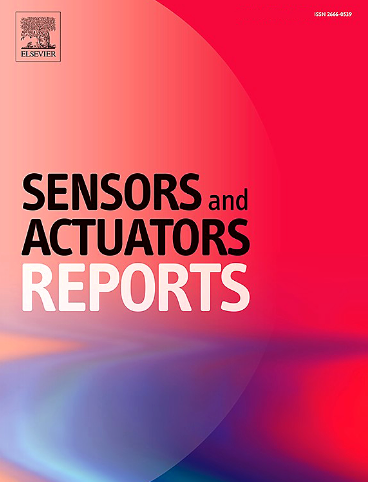基于钯纳米结构的无标签电化学生物传感器用于糖化血红蛋白和胰岛素测量
IF 7.6
Q1 BIOTECHNOLOGY & APPLIED MICROBIOLOGY
引用次数: 0
摘要
糖尿病(DM)的特点是由于胰岛素分泌不足或细胞对胰岛素的抵抗而导致葡萄糖调节功能受损。虽然胰岛素是主要的调节分子,但葡萄糖仍然是最受监测的生物标志物,尽管它具有很高的可变性。糖化血红蛋白(HbA1c)是一种更稳定、半衰期更长的标志物,可以全面评估长期血糖控制情况。同时测量HbA1c和胰岛素将为糖尿病的管理提供更好的见解。在这项研究中,我们提出了一种无标记的电化学生物传感器,能够使用一滴血同时定量HbA1c和胰岛素。该装置集成了用钯纳米结构(pdn)功能化的双丝网印刷碳电极,可以分别在WE1和WE2上共价固定抗hba1c和抗胰岛素抗体。经预处理的血样孵育后,引入过氧化氢(h2o2)作为测量溶液,产生电流信号:糖化血红蛋白血红素组在WE1处氧化,胰岛素干扰导致WE2处电流抑制。根据对测量溶液的电流反应对所有浓度进行量化。该生物传感器具有优异的分析性能,包括高灵敏度(R2 >;0.96),选择性(> 95%),长期稳定性(>; 95%超过120天)和操作效率,通过标准品和全血样本分析证实。这是第一个一次性的即时护理(POC)设备,可以在单个芯片上双重检测HbA1c和胰岛素,为实时监测糖尿病和个性化疾病管理提供了实用而全面的工具。本文章由计算机程序翻译,如有差异,请以英文原文为准。

Palladium nanostructure-based label-free electrochemical biosensors for HbA1c and insulin measurement
Diabetes mellitus (DM) is characterized by impaired glucose regulation due to insufficient insulin secretion or cellular resistance to insulin. Although insulin is the primary regulatory molecule, glucose remains the most monitored biomarker despite its high variability. Glycated hemoglobin (HbA1c), a more stable marker with a longer half-life, provides a comprehensive assessment of long-term glycemic control. Simultaneous measurement of HbA1c and insulin would offer enhanced insight for DM management. In this study, we present a label-free electrochemical biosensor capable of simultaneously quantifying HbA1c and insulin using a single drop of blood. The device integrates dual screen-printed carbon electrodes functionalized with palladium nanostructures (PdNS), allowing covalent immobilization of anti-HbA1c and anti-insulin antibodies on WE1 and WE2, respectively. Upon incubation with a pretreated blood sample and introduction of hydrogen peroxide (H₂O₂) serving as the measuring solution, amperometric signals were generated: oxidation of the heme group in HbA1c at WE1, and suppression of current at WE2 due to insulin interference. All concentrations were quantified based on current responses to the measuring solution. The biosensor demonstrated excellent analytical performance, including high sensitivity (R2 > 0.96), selectivity (>95 %), long-term stability (>95 % over 120 days), and operational efficiency, as confirmed through standard and whole blood sample analysis. This is the first disposable point-of-care (POC) device that enables dual detection of HbA1c and insulin on a single chip, offering a practical and comprehensive tool for real-time DM monitoring and personalized disease management.
求助全文
通过发布文献求助,成功后即可免费获取论文全文。
去求助
来源期刊

Sensors and Actuators Reports
Multiple-
CiteScore
9.60
自引率
0.00%
发文量
60
审稿时长
49 days
期刊介绍:
Sensors and Actuators Reports is a peer-reviewed open access journal launched out from the Sensors and Actuators journal family. Sensors and Actuators Reports is dedicated to publishing new and original works in the field of all type of sensors and actuators, including bio-, chemical-, physical-, and nano- sensors and actuators, which demonstrates significant progress beyond the current state of the art. The journal regularly publishes original research papers, reviews, and short communications.
For research papers and short communications, the journal aims to publish the new and original work supported by experimental results and as such purely theoretical works are not accepted.
 求助内容:
求助内容: 应助结果提醒方式:
应助结果提醒方式:


